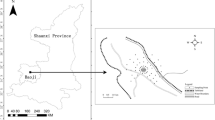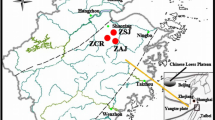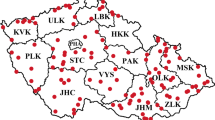Abstract
Lead (Pb) pollution in and around Ulaanbaatar is of national concern, given that the Mongolian capital is home to nearly half of the country’s entire population. By comparison, Mongolian countryside is a pristine environment because of its sparse population and low industrial activity. The concentration of Pb in urban soils (average of 39.1 mg kg–1) was twice the values found (average 18.6 mg kg–1) in background territories (i.e., Mongolian rural sites). Furthermore, Pb contamination was examined by using Pb stable isotopic composition, and covariance of Pb isotopic ratios showed two groups between rural and urban soils as pristine and disturbed sites. The 206Pb/207Pb ratio, the most prominent fingerprint for Pb pollution, was 1.163–1.185 for the urban whereas values for rural soils (1.186–1.207) were analogue to the regional Pb isotopic signatures. Local coal sources and their combustion products, one of the potential Pb pollution sources in Ulaanbaatar, have significant radiogenic properties in terms of Pb isotopic composition and revealed an average of 1.25 for 206Pb/207Pb and 19.551 for 206Pb/204Pb ratios. Thus, contributions from coal firing activity to Pb pollution lower than it was assumed, and smaller range of these values measured in urban soils may be attributed to the mixing of less radiogenic Pb as a constituent of the leaded gasolines.
Similar content being viewed by others
References
T. Batjargal, E. Otgonjargal, K. Baek, and J.-S. Yang, “Assessment of metals contamination of soils in Ulaanbaatar, Mongolia,” J Hazard. Mater. 184, 872–876 (2010).
L. Batnum and S. Enhmaa, Ulaanbaatar Hotiin Agaar Bohirduulah eh Uusveriin Uzleg, Toollogo Yavuulsan Tuhai Ajliih Tailan (Ulaanbaatar, 2008), pp. 40–41.
P. E. Biscaye, F. E. Grousset, M. Revel, S. van der Gaast, G. A. Zielinski, A. Vaars, and G. Kukla, “Asian provenance of glacial dust (stage 2) in the Greenland Ice Sheet Project 2 Ice Core, Summit, Greenland,” J. Geophysical Res. 102, 26765–26780 (1997).
A. Bollhöfer and K. J. R. Rosman, “Isotopic source signatures for atmospheric lead: the Northern Hemisphere,” Geochim. Cosmochim. Acta 65, 1727–1740 (2001).
H. J. M. Bowen, The Environmental Chemistry of the Elements (Academic, London, 1979).
J. Chen, M. Tan, Y. Li, Y. Zhang, W. Lu, Y. Tong, G. Zhang, and Y. Li, “A lead isotopic record of Shanghai atmospheric lead emissions in total suspended particles during the period of phasing out of leaded gasoline,” Atmos. Environ. 39, 1245–1253 (2005).
S. Cheng, “Heavy metal pollution in China: origin, pattern, and control,” Environ. Sci. Pollut. Res. 10, 192–198 (2003).
A. D. Clarke, Y. Shinozuka, V. N. Kapustin, S. Howell, B. Huebert, S. Doherty, T. Anderson, D. Covert, J. Anderson, X. Hua, K. G. Moore, C. McNaughton, G. Carmichael, and R. Weber, “Size distributions and mixtures of dust and black carbon aerosol in Asian outflow: physiochemistry and optical properties,” J. Geophys. Res.: Atmos. 109, 15S09 (2004). doi 10.1029/2003JD004378
F. J. Doucet and J. Carignan, “Atmospheric isotopic composition and trace metal concentration as revealed by epiphytic lichens,” Atmos. Environ. 35, 3681–3690 (2001).
I. P. Gerasimov and N. A. Nogina, The Soil Cover and Soil of Mongolia (Nauka, Moscow, 1984), pp. 109–112.
K.-S. Ho, Y. Liu, J.-C. Chen, and H.-J. Yang, “Elemental and Sr-Nd-Pb isotopic compositions of late Cenozoic Abaga basalts, Inner Mongolia: implications for petrogenesis and mantle process,” Geochem. J. 42, 339–357 (2008).
N. S. Kasimov, M. Yu. Lychagin, A. K. Evdokimova, D. L. Golovanov, and Yu. I. Pikovskii, “Ulaanbaatar, Mongolia (heat and power engineering): intermountain depression,” in Ecogeochemistry of Urban Landscapes, Ed. by N. S. Kasimov (Moscow State University, Moscow, 1995), pp. 231–248.
N. S. Kasimov, N. E. Kosheleva, O. I. Sorokina, S. N. Bazha, P. D. Gunin, and S. Enkh-Amgalan, “Ecological-geochemical state of soils in Ulaanbaatar (Mongolia),” Eurasian Soil Sci. 44 (7), 709–722 (2011). doi 10.1134/S106422931107009X
M. Komárek, V. Ettler, V. Chrastny, and M. Mihaljevic, “Lead isotopes in environmental sciences: a review,” Environ. Int. 34, 562–577 (2008).
V. I. Kovalenko, Rare Metal Metallogeny of People’s Republic of Mongolia Based on Potential Ore Resources on Magma Minerals. Ore Deposits of Magma Associations (Nauka, Moscow, 1988), pp. 114–159.
D. V. Ladonin and O. V. Plyaskina, “Isotopic composition of lead in soils and street dust in the southeastern administrative district of Moscow,” Eurasian Soil Sci. 42 (1), 93–104 (2009). doi 10.1134/S1064229309010128
F.-L. Li, C.-Q. Liu, Y.-G. Yang, X.-Y. Bi, T.-Z. Liu, and Z.-Q. Zhao, “Natural and anthropogenic lead in soils and vegetables around Guiyang city, southwest China: a Pb isotopic approach,” Sci. Total Environ. 431, 339–347 (2012).
L. Long, “Lead isotopes,” in Encyclopedia of Geochemistry, Ed. by C. P. Marshall and R. W. Fairbridge (Kluwer, Amsterdam, 1999).
A. Markwitz, B. Barry, and D. Shagjjamba, “PIXE analysis of sand and soil from Ulaanbaatar and Karakurum, Mongolia,” Nucl. Instrum. Methods Phys. Res. 266, 4010–4019 (2008).
Y. Meng, G. Gong, Z. Wu, Z. Yin, Y. Xie, and S. Liu, “Fabrication and microstructure investigation of ultrahigh-strength porcelain insulator,” J. Eur. Ceram. Soc. 32, 3043–3049 (2012).
MNCSM, MN 11047:2007: Soil Pollutants Standard of Mongolia (Mongolian National Center of Standardization and Metrology, Ulaanbaatar, Mongolia, 2007).
H. Mukai, A. Tanaka, T. Fujii, Y. Zeng, and Y. Hong, “Regional characteristic of sulfur and lead at several Chinese urban sites,” Environ. Sci. Technol. 35, 1064–1071 (2001).
H. Mukai, T. Machida, A. Tanaka, Y. P. Vera, and M. Uematsu, “Lead isotope ratios in the urban air of eastern and central Russia,” Atmos. Environ. 35, 2783–2793 (2001).
V. V. Nikonov, N. V. Lukina, and M. V. Frontasyeva, “Trace elements in Al-Fe humus podzolic soils subjected to aerial pollution from the apatite-nepheline production industry,” Eurasian Soil Sci. 32 (12), 1331–1339 (1999).
N. A. Onischuk, T. V. Khodzher, and E. P. Chebykin, “Chipanina lead and its isotopic ratios in atmospheric precipitation in the Baikal region and Primorski krai,” Geogr. Nat. Resour. 30, 345–349 (2009).
T. V. Pampura, A. Probst, D. V. Ladonin, and V. A. Demkin, “Lead content and isotopic composition in submound and recent soils of the Volga Upland,” Eurasian Soil Sci. 46 (11), 1059–1075 (2013). doi 10.1134/S1064229313090020
M. Satoshi, N. Kazuki, D. Gunchin, and H. S. Soey, “Mercury content in electrum from artisanal mining site of Mongolia,” Nucl. Instrum. Methods Phys. Res., Sect. B 249, 556–560 (2006).
B. R. T. Simoneit, M. Kobayashi, M. Mochida, K. Kawamura, M. Lee, H. J. Lim, B. J. Turpin, and Y. Komazaki, “Composition and major sources of organic compounds of aerosol particulate matter sampled during the ACE-Asia campaign,” J. Geophys. Res.: Atmos. 109, 19S10 (2004). doi 10.1029/2004JD004598
D. S. Soper, Analysis of Variance (ANOVA) Calculator, 2015. http://wwwdanielsopercom/statcalc
O. I. Sorokina and S. Enkh-Amgalan, “Lead in the landscapes of Ulaanbaatar city (Mongolia),” Arid Ecosyst. 2 (1), 61–67 (2012).
Sh. Tserenpil, O. D. Maslov, N. Norov, C.-Q. Liu, M. F. Fillipov, B. K. G. Theng, and A. G. Belov, “Chemical and mineralogical composition of the Mongolian rural soils and their uranium sorption behavior,” J. Environ. Radioact. 118, 105–112 (2013).
UNEP, Target 2008: Global Elimination of Leaded Petrol. A Report of the Partnership for Clean Fuels and Vehicles (PCFV) United Nations Environment Program (Nairobi, Kenya, 2008).
A. P. Vinogradov, The Geochemistry of Rare and Dispersed Chemical Elements in Soil (Consultants Bureau, New York, 1959).
F. Wu, H. S. S. Hang, Q. Sun, and I. S. H. Sai, “Provenance of Chinese loess: evidence from stable lead isotope,” Terr., Atmos. Ocean. Sci. 22, 305–314 (2011).
Author information
Authors and Affiliations
Corresponding author
Additional information
The article is published in the original.
Rights and permissions
About this article
Cite this article
Tserenpil, S., Sapkota, A., Liu, C.Q. et al. Lead isotope and trace element composition of urban soils in Mongolia. Eurasian Soil Sc. 49, 879–889 (2016). https://doi.org/10.1134/S1064229316080147
Received:
Published:
Issue Date:
DOI: https://doi.org/10.1134/S1064229316080147




